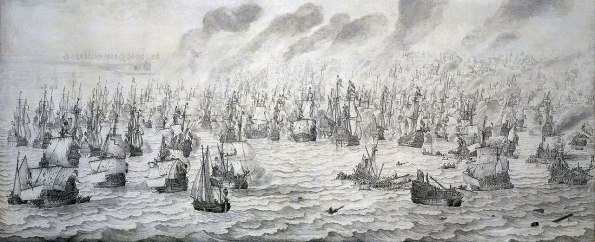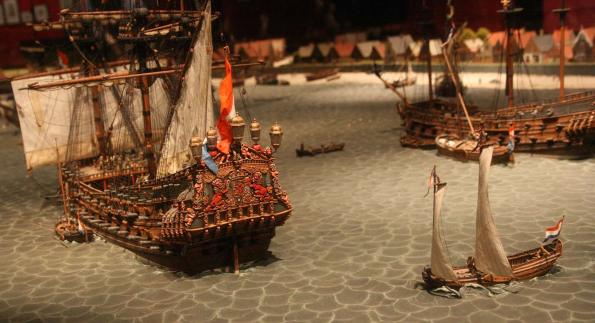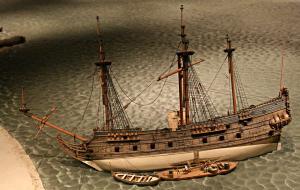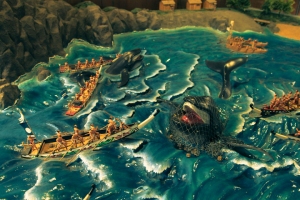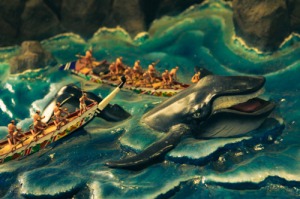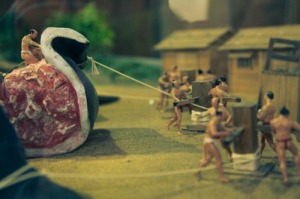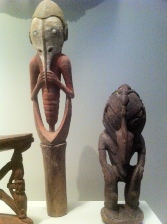Archive
Counter-colonial Heistcrawl: previous high scores
One of the reasons I’ve been blogging so little here of late is that it inevitably takes me a whole day to write a post. I’m going to try to keep this one short because it’s a simple point, relevant to the campaign I’ve just started running (after 15 years gestation – that might be why I’m reluctant to start campaigns, too).
Have you seen Black Sails? It’s trashy but better than I expected (see previous post). In fact on the trash violence to interesting plot axis, I think I prefer it to Game of Thrones.
It so happens I’m discovering it just as my son is re-playing Assassin’s Creed 4 (the pirate one – Black Flag). Both treat the same loosely-historical events in fairly similar ways – the struggle between the pirate anarchs (sometimes dignified as a republic) of Nassau and the nascent British Empire, the latter personified by Woodes Rogers with his pardons and pirates-turned-king’s men. The historical events take place during the period 1715-1720. The TV and video game versions seem to compress it all into a few months.*
So. 1715 is a terrible time to be starting a pirate republic:
- there’s more peace between the big pirate empires – Britain, France and Spain – than in the previous hundred years or more. As a group they are disinclined to welcome a competitor (cf. WW1, which was really about not wanting to set a place at the Great Power table for upstart Germany).
- although there are plenty of malcontents in the American Colonies, the local power-holder landowners still look to the homeland for preferment – if you want to start up an American Revolutionary Republic in 1715 you first have to engineer a real peasant uprising and kill all the aristos and then still have resources and trade networks to fight off the British counter-attack. In case you’re thinking the actual American Revolution offers a better model, note that it’s a tax revolt by an already-established gentry class – people who already have a working political system for controlling the masses, which they can adapt to new ends. Every fort they can take by ideology rather than force is part of a political machine the English built for them.
- the British are already thoroughly networked across the Caribbean and if nobody stops them they will certainly colonize it all. They have a lot of ships, a lot of places to repair them, and a lot of resources to recruit crews. It seems anarchic and it’s definitely full of holes a ship or captain can hide in, but it’s the anarchy of capitalism – there are in fact even venture capitalists in London and Boston trying to exploit the temporarily-anarchic situation by sponsoring “privateer” agents abroad, which is as sure a sign as you’re likely to find anywhere that the pirate bubble is about to burst.
Both Black Sails and Black Flag do a good job of peeling apart the micropolitics of trust that are the basic problem for any gang of murderhobos that wants to turn into a working polity – not everybody understands the same things at the same time. Many people just want to be murderhobos. Nobody wants to invest their treasure in a communal chest. Independent ship captains already command pirate republics (wooden ones) – why should they want to be represented by some wig-wearing tax-collector on land?
But neither one really addresses the bigger picture of why a republic in Nassau is doomed to failure, while one that encompasses the eastern seaboard of North America just might work. Fair enough, dramatically – the pirate genre is really all about Great Man history, not long-reaching economic forces – but that bigger picture is important to the kind of exercise I would like CCH to be. In CCH I want the players to seriously consider first what they have to do to survive the day, and later what they have to do to make a safe space for themselves and people like them. And they can learn (anachronistically) from the mistakes of Blackbeard, Vane, Anne Bonny and all…
- the Caribbean pirates never try to make allies, except among equals. They probably fear to lose their independence (fair) but by victimizing everyone indiscriminately, they make themselves the common enemy of all. They do not learn to play politics. England (later Britain) tries several times to recruit them when its own prospects are uncertain. The pirates keep refusing because they rightly guess that Britain will never offer a really good deal – their problem is they lack the presence of mind/discipline to lie to her convincingly (with some exceptions).
- they’re trying to establish themselves in the very heart of the imperial project. Caribbean sugar is the starter fuel for colonizing the Americas. That’s why there’s so much merchant shipping to prey on, but it’s also the resource that the imperialists will fight hardest to keep. Basically the Navy will come here sooner or later, which is not true of Madagascar or Mauritius or even the coast of India if you know who to attack (smaller native capitalists, Mappilas, the Portuguese) and who not to attack (the British or French) there.
- they declare a tiny castle outpost in defiance of nation states. There’s really no way they can get big enough to become a real threat because they’re not ambitious enough and they’re too public, too early. Compare and contrast with Germany, which definitely won its pirate phase – Prussia was a dead state in 1814. It was reconstructed after Napoleon to act as a buffer between Russia and Europe. It reformed its armies (took care of getting the best equipment), seized a bunch of German-speaking pocket states that the big players didn’t care about (grew in the dark) and focused hard on industrializing (exploited a technological weak point) until it was big enough to be a threat… and then it moved (in restrained ways as long as Bismarck lived) on the big, old players.
- ETA: my son makes an excellent point: Nassau is also never self-sufficient. Black Sails suggests it could be if it made an alliance with the planters of the island but it doesn’t, so there you are.
I’m not saying that CCH must follow my vision of a teleological course, I’m not saying it’s the game where you emulate Prussia or anything like that, I’m just saying the pirates of Nassau show some classic traps.
1610 (the opening date for CCH) is a much kinder moment to start than 1715, if you did want to build a strong, working polity in Southeast Asia. The Spanish and Portuguese have been annoying the locals for a century and all they’ve got to show for it is a trading post empire of isolated fort-factories sitting on a set of resource-flow routes – one for cinnamon, one for pepper, one for dye-woods…. not the kind of thoroughly interlinked plantation colony Britain will develop in the Americas a hundred years later. The legal control environment is not so much a Swiss cheese as a few strands of spiderweb stretched across a dark and unknown jungle. Nobody even knows all the kingdoms out there, and inside those kingdoms, nobody has hegemonic control of anything – the general political mode is to have villages pay tribute to warlords when they can be forced to, not nation states with defended borders. Stone forts are rare (and are generally either European colonial, Chinese, Japanese or Mughal).
Perhaps most critically, the fundamental basis of power is not land or even money but manpower. That’s what local rulers fight over, and what Chinese commercial networks export, in return for unique island products. It’s what the European colonists really need (even if it’s not what they most desire). There is rich loot to be grabbed in the form of spices, Spanish silver, Indian gold, sea cucumbers (the Chinese love ’em), perfumes, dyes, cloth etc. so there’s ample opportunity for piracy, trade and smuggling, but the key to long-term success – the key to independent survival – is nakedly and unquestionably uniting people.
* There’s basically one literary source for all this “history” and it’s superbly written, so it’s ideal genre fiction writing fodder and it sparked a pirate genre that’s still playing out today. Seriously, Captain Charles Johnson was the Tolkien of 1725 (or maybe he was Daniel Defoe all along – the case is not definitively settled) – if you want to be an instant expert on the “golden age,” go read him (the paperbacks are cheap, the etexts only cost you time).
** Black Sails has some gorgeous imagery, though. The carved ivory title sequence is a delightful synthesis of familiar elements into a typically 18th century harmonious, murderous whole.
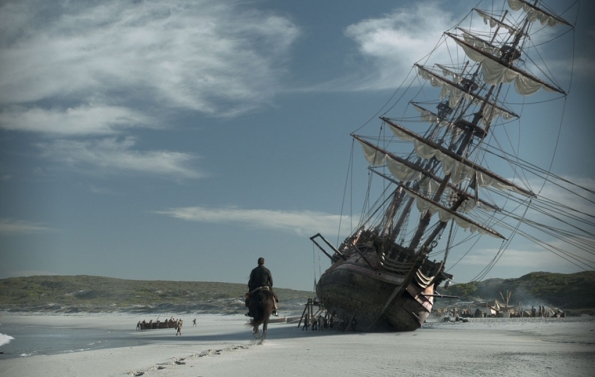

Countercolonial Heistcrawl: some maps
Over the past year or so I’ve concluded that the best way to make progress on CCH is to start a campaign, and for that I need some campaign materials – factions, equipment/units, characters… and maps.
…..for player-facing maps I like period productions a lot, with all their elisions and doubts:

Here’s the whole spice islands region, a couple of thousand miles across.
If you’re playing non-Europeans there are excellent reasons for not using these European charts. Still I think the style gain from using something more culturally appropriate…
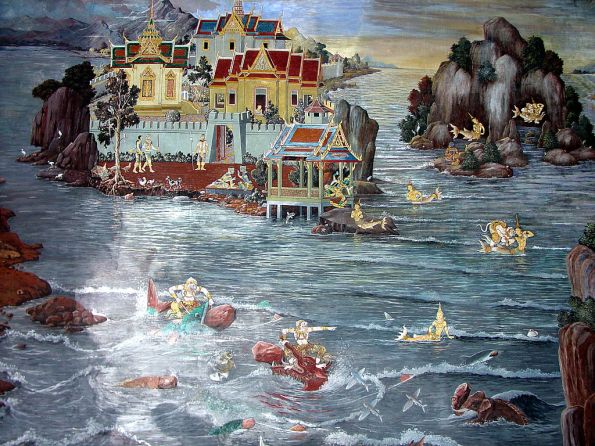
is probably exceeded in usefulness by the gain in clarity of using something more recognisably map-like, with some pretensions to uniform scale.
…all that said, charts on a suitable scale for tactical encounters are really a recent development, and CCH’s landscape isn’t supposed to map precisely onto Earth’s (after all, I want players to contribute their own islands without fear of having Indonesians or Malaysians complaining that they’re misrepresenting their people), so I’m moving away from just using Google Maps co-ordinates.
Blah blah blah here’s an area map for the game, lifted and lightly toasted from some geographically-appropriate islandy bits – obviously, ignore text and (most) roads marked on it. Hexes are 6 (nautical) miles across, so this map is about 150 nm wide:

The game starts at 2 tiny islands that are rather dimly-outlined on this map – here, zoomed in and highlighted:

Here’s a tactical-scale map of those islands – hexes are 100 yards (20 hexes to a nautical mile), per the last post’s ship combat rules:

Water depth in this last map is keyed to the draught of different ships – a big East Indiaman can sail safely in the darkest part, the lighter part would be deep enough for a size 3 cargo vessel, the lightest blue is for size 2, 1 and reed galleys only, and white is exposed beach sand.
No prize for identifying the islands I swiped for either of these – in fact, if you research them it’ll probably mislead you.
Counter-colonial Heistcrawl Rules v 0.1
To people waiting for TikinD part 2, sorry, you’ll have to wait a bit longer.
To people who’ve been waiting for CCH for like a decade, well…. this is very far from complete but it’s the best way I know to share the current state and crowdsource feedback on it. I would like to start running CCH in the fall this year (hahahaha), so this is trying to get that moving. If you’d like to play over hangouts, please comment here or on G+
The basic concept: it’s 1610. You are ordinary inhabitants of a more-or-less historical Southeast Asian archipelago that looks and smells a lot like the Spice Islands.

The Portuguese have been around for a century and everyone hates them, but they’re more or less stalled. Now the Dutch have shown up and they’re like the Portuguese on steroids. They’ve already attacked 2 islands and demanded tribute, so what are you going to do?
The obvious answer is: UNITE THE PEOPLE! GET ALL FLASH GORDON ON IT AND THROW OUT MING. This might be that game. It’s not so easily done, though – there’s already the Portuguese and Spanish (ugh), there are English people sniffing around (smell like Dutch but pretend to be nicer?), there’s Chinese mafias and expansionist Mappilas from India and warring sultans and roving bands of slavers and the Japanese are acting weirdly secretive and expansionist at the same time. And there are even actual Ming loyalists (Chinese Ming, like the porcelain), who say they need to take China back from someone or other. And something’s got the old spirits all riled up.
Oh yeah, spirits.

They’re everywhere but it’s easy to think they don’t exist. The Dutch don’t seem to believe in them, although some people say they’re working for some big dark spirit. Sometimes you can catch them in contracts, or in jars, but that’s dangerous work. Think Princess Mononoke and Spirited Away and Yokai and… sure, Pokemon I guess.
Mechanically it’s some sword-waggling, piratical RPGing on a more-or-less DnD mould and some Civilisation-type domain gaming – if Civ were based on actor-network theory and not Toynbee/Gordon Childe technological determinism. When people join together to do actions they do them better, so even on the rowboat where you start, you should be thinking about yourselves as a unit, not a party of individuals.
Wait, what? Combining together
Essentially, you’re like slightly lower-powered Risus characters – you have 3d in your professional skill, 2d in a second skill and 1d in a hobby and you roll off against your opponent and the winner wins the round, and then they erode the enemy’s ability to resist by 1d, demonstrating to them that they have entered a death spiral and should make alternative plans. Fine.
BUT unlike Risus if a friend comes to help you, then together you can add 1d to the skill of whoever is taking the lead. If a total of 5 people band together then they can roll one roll at +2d. 10 people makes +3d, and so it goes, 20, 50, 100, 200 etc etc.
To usefully add to a skill, at least half the people combining must have at least 1d in it or something related. (I thought about going with strict doubling ie powers of 2 but I figured (a) people might be more familiar with the old coinage 1-2-5-10 scheme and (b) if anyone was really fussy about the numbers and power steps that might be a sign that this isn’t the game for them.)
Sure, there are some things this won’t work for (proverbially, making broth. More obviously, sneaking), but for building ships or castles, or for fighting, or for persuading local rulers/godlings of your sincerity, it works great.
And if you can add boats or cannons or pikes or walls to your efforts, then you can get bonus dice from that too (*full, flawless, intuitive system/schema TBD).
So, obviously, splitting apart
…is the key to the whole exercise. Add to your network, weaken the enemy’s. And that’s why it’s a heistcrawl: mostly you’re 2-5 randos out in the weeds trying to make trouble for the world’s greatest and most ruthless exponents of capitalism. So you fetch up outside a coastal fort full of wine-soaked Portuguese dons, bristling with cannons, and…

what? Frontal attack? Hardly. The trick might be to sneak in, poison the well (penalty to numbers, fighting ability), plant contradictory orders (dividing officers and forces), kidnap the priest’s girlfriend (sabotaging a morale specialist), wet the powder and spike the guns. Then gather all the drunks and ruffians you can find and charge the fort yelling as hard as you can, watch the Portuguese flail around, get cursed by their magic man, fail to fire anything and eventually run off into the jungle where you can pick them off 1 and 2d at a time.
Chargen
So it’s not quite Risus. You get 3 skills/tropes – one at 3d, one at 2d, one at 1d. They should be of the breadth of sailing, gunnery, melee, riding, shipbuilding, animalcraft, plantcraft, spirit sense – not as narrow as “sword” nor as broad as “thief.”
Also choose a profession. This is what you appeal to when you say “but I should be able to do this because I’m a _” and it gives you 1D or a default roll off your attributes when successfully invoked. Example professions include: pirate, smuggler, concubine, procurer, medium, monk, bodyguard/mafia hood, magistrate, spirit medium, cunning man, builder, fisherman, whaler, scout, merchant, legal opiner, scholar, “viking” slaver, diver, navigator
Also roll 6 DnD type stats, but only record the bonuses/penalties (+1 for 13-15, +2 for 16-17, +3 for 18). These are straight numeric mods (eg 3d for archer +1 for dex bonus) except if there’s a pure exercise of attribute (eg bend bars/lift gates for str), in which case you can roll it as dice like a skill. Wis is perception of spirits, Cha doubles as magic power.
Default status
is freeman/basic sailor/soldier/merchant’s agent/farmer.


If you’re secretly a ship captain/priest/village judge/longhouse master/princess that’s fine, write your story. But you start the game without the benefit of that higher status because you’re far from home and nobody cares.
Equipment
Also you don’t get a Risus-type thematically-appropriate comedy backpack of tools. Life is hard and people with a lot of loot tend to get stabbed in the Moluccas.
Level of Destitution (d6)
- shipwrecked. You have sodden clothing and personal effects up to earrings, hair ornaments. Also roll 1d6+8 on Table B. Save vs. INT or you’re also suffering from amnesia
2. where’d you get that? roll 1d6+14 on Table A and 1d12 on Table B
3. one good friend. You have the basic tool of your trade** plus roll d8 twice on Table A and 1d12 on Table B
4. practically minded. You have the basic tool of your trade** plus d12 twice on Table A and 1d6 on Table B
5. expert scavenger. You have a machete plus 3d20 on Table A
6. Temporarily distressed person of substance: roll 3d20 on table A, 2d12 on table B
** a kris or a marlinspike or a feely map or spirit-wrangling flywhisk or grapnel/multitool or glassware or whatever.
Table A
1. crowbar
2. dagger
3. shield
4. food, drink and backpack
5. lamp and flasks of oil (3)
6. melee weapon
7. armour: leather or improvised equivalent
8. bow or crossbow with 10 arrows/bolts
9. small raft (size 1)
10. mirror
11. rope (50′)
12. grappling hook/anchor
13. pouch with 20 silver dirhams
14. musical instrument
15. hammer, chisel, pick + 8 iron spikes
16. writing box and seal
17. arquebus + 10 shots
18. small barrel of gunpowder.
19. Barrel of arrack
20. 3 caskets grape shot, with powder
Table B
1. lucky medallion (re-roll 1 failed saving throw)
2. potion of healing
3. lockable iron-bound chest
4. guard animal (dog, lynx, monkey or similar)
5. riding or pack animal (camel, pony, goat)
6. size 2 boat
7. armor: scale or exotic
8. loyal family retainer ( a standard grog with a couple of charming quirks).
9. map
10. book – holy text or instruction manual
11. holy symbol or badge of office
12. spirit in a jar
13. slip of paper with a spirit contract – eat and then specify what you need
14. bird in a cage that repeats spirit chatter
Mustering-out Hooks
You may draw once or twice from the Barrel of Many Things
Things in the world that have something to do with you:
- a ship
- a fort, bay or haven
- a contact – smuggler, informant, fence, carpenter, smith, spirit go-between
- a weapon – cannon, bomb, spirit, blackmail, poison, disease
- a debt – blood, goods, mafia, spirit
- a diminished god from a foreign land
- a massive cache of gunpowder
- several gallons of the interloper’s “holy water”
- a sibling rival – kite pilot, long-distance swimmer, pirate, magistrate/king/official
- the washed-up corpse of something massive
- a spring that bubbles with blood or a cistern filled with teeth
- Hungry Grandmother’s bottle of secrets
- a funeral barge, surrounded by silence
- a Dark Child
- a commander of the invaders, disgustingly ill, on a mission
- one of the enemy’s ships, on the edge of mutiny
- one of the enemy’s Holy Books, foolishly translated into a tongue we understand
- the ashen remains of an ancient Obsidian Queen’s funeral pyre
- a relic of a foreign saint
- one of the teeth of Brother Shark
Your relation to it:
- It’s rightfully yours but currently captive
- It’s marked on this map
- It’s known to be abandoned, there for taking,
- It’s lost in a useful way
- It’s in danger from something esoteric
- It’s been swiped by an enemy
And/or:
- you are blessed/cursed in some way
- you are bonded/owed in some way
- you have a mysterious ally/enemy
- your memories/skills/loyalties/reputation/status/soul have been stolen/augmented/crippled/replaced
- your tribe’s priest/captive spirits need you and only you
- you are a captive spirit
Experience
If you achieve some goal or do something remarkable that really changes the world around you in a session (lay demon to rest, steal large ship, rout fort, corner the market in candles made from Europeans) add 1 skill point. To increase a skill, beat its current value in points (4 points allows you to increase a 3d skill to 4d).

Ship combat
I can’t believe it’s taken us this long to get here.
We play on hex maps because we are geeks an they suit our tastes.
1 hex = 100 yards. 20 hexes = 1 nautical mile
1 round = 1 minute.
You cannot sail into the hexside from which the wind is blowing.
You can row in any direction.
Ship size
Ship size refers to a combination of factors – for sailing ships it maps closely to the crew requirements, which also model the number of dice of skill required to control the ship.
If a ship has double the crew required, all rolls are at +1 (not +1 die, just +1). Once you have twice as many crew as the ship requires, the remainder are simply passengers (or, more likely, a second or third Watch, allowing the ship to operate while some crew members are asleep).
Ships will founder if their cargo capacity is exceeded. 1 crewman or passenger may be carried per ton of cargo capacity left open for them.
If the crew is too small for the ship’s requirements, the ship resists sailing – roll its size in dice against the commander’s skill (with mods). Most ships have their own spirit – if this can be persuaded it may add to the commander’s dice pool or simply allow command.
A ship of Size 1 = 1 crew required; raft, rowboat: carries 1 ton or less of cargo in addition to the crewman.


Size 2 = 2 crew required. Typically 15-40’ sailing boat. Typically carries 1-10 tons of cargo/passengers. Cutter, workboat, pinnace
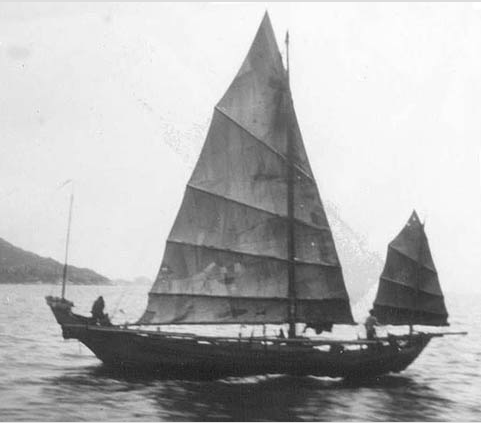

Size 3 = 5 crew required. Typically carries 10-60 tons. Prahu, large Sampan, small Junk/Jong, Dutch sailing barge, small dhow, small galley


Size 4 = 10 crew required of which 1 mate in addition to captain. Typically carries 60-150 tons. Duyfken, fluyt, Chinese ocean-going junk, large dhow, war galley like in the Battle of Lepanto, average war coracora



Size 5 = 20 crew of which 4 are mates/petty officers. Carries 150-500 tons. Golden Hind, large fluyt, large junk, largest booms, flagship coracora



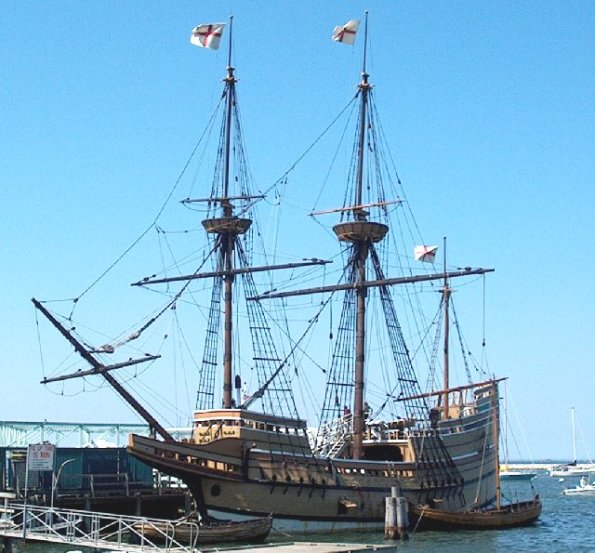
Size 6 = 50 crew, at least 9 of which are mates/officers. 500-2000 tons. East Indiaman, largest junks, largest naus/carracks


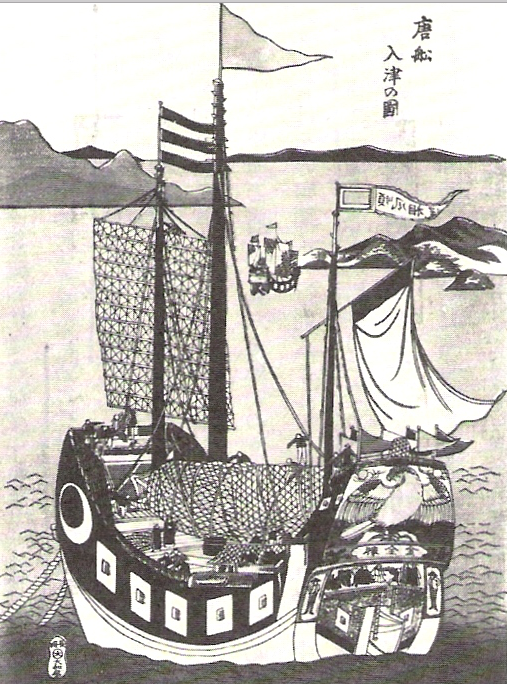
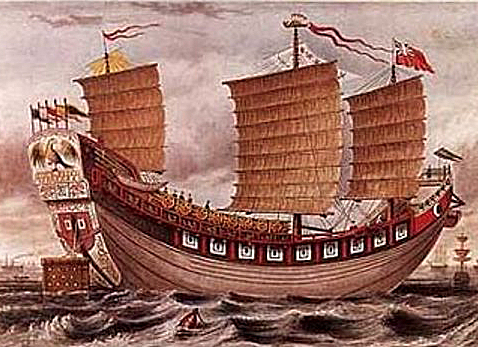
Size 7 = 100+ crew of which 19 officers. 2000-10000 tons or more. Zheng He’s treasure ships, legendary Srivijaya jongs.

Light and Heavy Construction
The baseline construction for ships here is Indian wooden planks, sewn together, cross-braced with decks at size 4+.
Ships may be made lighter – from hides stretched over bamboo frames (for size 1 or 2 only) or from reeds (theoretically any size). This gives them -1D for resisting gun fire, but may give +1 hex movement.
They may also be made heavier – from timbers fastened together with wood or metal nails, with heavy internal bracing. All junks/jongs and European vessels of size 4+ are made this way. This gives +1D to resist gun fire but -1 hex/round speed.
Rowed ships
Rowed ships need 1 step more crew than sailed ships for the same size of ship, so while a size 4 sailing ship requires 10 crew, a size 4 rowed ship requires 20.
If the ship is purpose-built for many rowers (making it a galley) then the number of rowers may be increased by 1 step, increasing speed by 1 hex/round. You cannot increase speed by more than 1 hex/round this way.
Rowed ships can charge for 1 round per die the commander has in leadership. Charging increases speed by 50% (round up).
Examples
An English galleas is really made for sailing but may be rowed in extremis. It is heavily built, so -1 hex speed. It is not a galley, so cannot be usefully overmanned with rowers. So if it is adequately manned (10 crew for a size 3 galleas) it may do 1 hex every 2 rounds under oars. If charging it can manage 1 hex/round. For performance under sail see below.
A Timawa coracora is a lightly built (reed) galley and the Viking/slaver Timawa commonly double-crew them. Such a double-crewed coracora can do 3 hexes/round. The Spanish were alarmed to find them capable of burst of 15 knots – that is, they can do 5 hexes/round when charging.
Weather and ship size and range
Weather is rated 0-6
If your skill + help from the crew exceeds the weather, you don’t have to roll. If they’re equal/weather is bigger, you roll – its rating is how many dice it rolls. If you lose a roll-off, you take damage to hull strength.
Crew help only counts if it’s from officers – you should have 1 officer per 10 crew. All officers must have at least 3d (professional level) in an applicable skill (sailing or leadership). So if for example you have 3d in captaining and a size 4 ship (10 crew, including 1 officer/first mate) then conveniently you get 4d skill to go with your size 4 ship.
0 = becalmed. Ranges can extend to full, only rowers can move.
1 = breeze suitable for dinghies, no penalties for anyone moving, cannons etc limited to 5 hexes effective range. All sailing craft do 1 hex/round (modified for build, as noted above).
2 = windy. 2 hexes/round.
3 = topgallant breeze/choppy. Size 3+ do 3 hexes/round, size 1 or 2 and galleys do 2 hexes in their desired direction and drift downwind 1 hex
4 = gale. Size 3+ can do 2 and drift 1 downwind. Size 1 or 2 and galleys do 2, drift 2.
5 = storm. All ships do 1, drift 3
6 = hurricane. Drift 5.
So e.g: the Duyfken, a size 4 Dutch jacht, sees a storm on the horizon (weather 5). The captain is professional (3d in captaining) and has 1 mate (out of 10 crew, all as it should be), so they get 4d to roll against the 5d storm. They would be well advised to run for a harbour.
Astute readers will have noticed that large Dutch ships with competent captains and well-ordered crews only have to roll against the worst hurricanes/typhoons. This seems to be historically accurate. Notably, when Dutch ships were lost accounts tended to blame either division in the crew (reducing dice by 1) or a bad officer standing in for the captain or, rarely, pre-existing damage that would’ve given the ship a reduced effective hull size/strength. The latter condition is much more common in English accounts from the 18th century.
Turning
If you’re rowing, then turning 1 hex side costs half a hex of movement, rounded up – ie turning 1 or 2 sides costs 1 hex worth of movement. Turning 180 degrees (3 hex sides) costs 2 hexes worth of movement. While turning you do not move forward.
If you’re sailing, it costs half a hex of movement to turn 1 hex side, rounded down. So you can turn 1 hex side for free each round. If you want to turn more than 1 hex side then it costs 1 hex for each 2 sides you turn. Turning 180 degrees (3 sides) costs 1 hex of movement (1.5 rounded down).
Exception: crossing the wind with the bow (tacking) always costs 1 extra hex of movement for a sailing vessel, so it costs 2 hexes total to tack across the wind – 1 for the 2 hexside turn, 1 extra for crossing the wind. It is therefore equally costly to tack as it is to “wear” ship (turn downwind and then up the other side, crossing the wind while facing away from it or jibing, to use modern British parlance).
Shooting
Small arms (arquebuses, bows, spears) only damage ships of size 1.
Swivels only damage ships of size 1 or 2. They might as well always fire grape shot.
Cannons damage everything.
Ranges
Spear = same hex
Bowshot = 1 hex
Arquebus/snaphance/swivel = 2 hexes
Cannon = 5 hexes
Cannons firing grape shot = 4 hexes
Culverin (long range, small-bore cannon) = 15 hexes
All ranged weapons can shoot at double range for -1d effectiveness. Roll gunner/archer skill of leader, modified by how many weapons are shooting in a volley (2, 5, 10 etc).
Weather limits range of shipboard weapons – becalmed (weather level 0) allows guns to shoot their full range, level 1 limits all weapons’ range to 5 hexes. Every level increase decreases total maximum range by 1 – so at weather 3 cannons have range 3, arquebuses still have range 2, archers still have range 1.
Cannons
Cannons are carried on 2 even broadsides and optionally a few facing front and back. If there is just one big gun, it faces forward or back.
Damage is by weight of shot and rolled vs hull strength (for round or chain shot) or crew size (for grape shot) – 1lb = 1d, 2lbs = 2d, 5lbs = 3d etc.
The Batavia (size 6) carries 50lbs (6d) of cannons on each side + 10lbs forward and back.
If a ship carries more dice of cannons than its size it is overloaded and at -1d against weather.
Culverins are special long range cannons (15 hexes). They are never larger than 8lbs each. Really truly they shoot half the poundage of balls we count them as, but it doesn’t matter because the guns and powder charges and damage are all doubled so just count them like other guns but long range.
Hazards of cannons
Most cannons are bronze (“brass”). These can fire 1d6+2 times in a battle before they heat up and risk exploding (cannoneer’s skill sets the limit – roll vs 2d difficulty)

Iron cannons are strangely unpopular and poorly controlled, but can potentially be much better than brass (people with money will realize this quite soon).

Any time a crap iron cannon is fired, if it gets all sixes or 4+ sixes on the roll it explodes.
Good iron cannons can shoot indefinitely without risking exploding.
There are also “wood” and “leather” cannons. These might be like crap iron guns or like brass guns or something worse. They definitely don’t sound good and they didn’t catch on once lots of foundries were established, so.
Any cannon can come loose, especially if damaged in combat/storms. A loose cannon goes flying about the deck when fired, forcing its crew to save vs. a messy and sudden death.
Dutch ships in the 17th century: a diorama for CCH
One day soon (goaded by Michael Moscrip) I’ll post an actual thoughtful gaming article full of usable goodness, but from now until Christmas it’s gonna be lazy photoposting.
I’ve talked before at length about the diorama as an art form and a form of knowledge (and if you want more of that go read Steve Quinn‘s delightful book and hunt through the archives at fuckyeahdioramas). This here, though, is (a) pure pleasure; (b) a handy establishing shot of the Borg Invasion Fleet for Counter-colonial Heistcrawl –
the diorama of the Texel roadstead at the Jutters Museum, on Texel in the North Netherlands:
Texel is an island just off the coast of north Holland, strategically situated where the unfettered North Sea hits the sheltered and shallow “inner” or South Sea (Zuiderzee). The island has abundant water that stays drinkable for an unusually long time in barrels (due to some mineral inclusion I don’t really understand) and livestock. Through the period of the East India Companies the “roadstead” (shallow narrows between the island and the mainland) was the premier staging point for fleets leaving the Netherlands in all directions.
Ships would gather at Texel to wait for a favourable wind and tide to sweep them out into the North Sea and English Channel – sometimes for months at a time. They would be repaired and refitted and emptied of cargo and filled with fresh crew while at anchor in the Roads. If you wanted to gauge Netherlands sea power, your best bet was to hang out at Texel.
The diorama shows it “sometime late in the 17th century” – before the lustre had gone off the Golden Age. And I don’t know how many ships is has, but it’s a lot.
If you plan to play CCHeistcrawl and you really want to be alarmed about the navies that will grow up out of the first half of the 17th century, check out Willem van de Velde’s pictures of them arrayed against each other, fighting over ownership of the Atlantic:
The diorama shows merchant ships, whalers, fighting ships. Ships with battle damage from one of the Anglo-Dutch Wars:
Warships whose decorated spiegel sterns bespeak notable captains.
Little service vessels bustling around the great hulls like birds on a hippopotamus.
And everywhere contrasts: between the big ships and the little houses of the people that serve them:
between those houses and the cannon fort that defends the mouth of the Roads:
and between the costly business of war and the ruthless efficiency of Dutch trade:
that last image – the Baltic fluyt – is what the Dutch want to bring to the East Indies. Minimal crew, narrow deck, hull stretched out for cargo like an old shoe. That’s the ship that feeds the kitchens of Amsterdam with grain. Useless for fighting, optimally adapted for bulk extraction of resources. It only operate in places where you’ve already won the wars. In our own timeline it won’t be a practical instrument of colonialism until after the 1760s, and then it’ll be the English who wield that power, and they’ll adopt the faster Blackwall Frigate, and later the even faster clipper:
In the meantime (1600-1800, more or less) the Dutch will rely on their big East Indiamen, difficult to tell apart from warships:
(the East Indiaman is on the right), heavily armed and crewed – vehicles for soldiers, sailors (European, Chinese and Malay), guns and pepper. They’ll station old, leaky ones on port defense and shuttle routes around the Java Sea, and use them to provide an artillery backbone for the fleets of native canoes and caracoas that will fight all those obscure internecine wars between local princes that will slowly, but surely, grow their influence and colonies and arrogance.
But they won’t be easily dissuaded. See, the Indies trade will supercharge their economy – which they need because they’re already in massive growth of population and a war for independence with Spain. From 1600 t0 1665 Amsterdam, hub of the Indies trade, will grow sharply, from this:
to this (click to make much, much bigger):
It’s the realisation of a plan they come up with in 1610 – the year CCH begins – because right then they can see that they’re going to need a lot more city. For more and bigger houses, to accommodate their wealth. And although not all that growth can be credited to the East India trade (and it’s hard anyway to pick apart the influence of one trade among many in forming a commercial hub and economic powerhouse), some specific centres can be identified directly as indispensible parts of the machine:
Reward for getting this far: a bunch of fun dioramas from fuckyeahdioramas, including some delightful Japanese whaling ones especially for Arnold K:
Our archipelago (Counter-colonial heistcrawl could be the new Sea of Osr)
Guys, I am astonished and humbled by the response to Counter-colonial Heistcrawl, and it hasn’t even started yet.
I’m running this campaign a bit differently from usual: it’s more of a collaborative creation. I know some parts,* but the players are coming up with others. In particular and right off the bat, they’re creating their home islands, shortly to be contacted and eventually colonized (if the players don’t do anything about it) by Perfidious Dutch and English men. And they are, without exception, exceptional. Like, damn.
First, Patrick Stuart’s Pat-Te-Chack-Ha, the island at the centre of the world.”Remember almost everything in the world is poisonous. The only way to avoid the poisons is to get exactly the right foods and mix them in exactly the right way. If you do this, the poisons cancel each other out. If you go ‘out there’ to the edges of the world and you see anyone mixing foods when they eat, always do exactly the same thing. …You can always cancel out a tabu or a sin with a different tabu or sin. But they have to be exactly right. If you can keep your actions even, you will be ok when you die.”
While James Young’s Kuna Kuna is at the end of the world.
“When your baby is born …you must choose the fate of your child. Carve a secret symbol into the walls of a god’s old chamber, do not tell anyone what you chose. This gives your baby the protection of that god’s children. When you are close to death you may tell your child the secret symbol you carved those years ago. If your child is far away you must tell another, but that person must tell your child as quick as he can or bring calamity on both. This is a spell of oath.”
Jason has sneaked some AmTart under the bamboo fence with his Cooly Islands:”In the end a new leader was appointed. The fairest skinned of our people, Los Blanco. His first act was to take control of the waterways and that was a wise thing. He starved out many traitors and those who clung to the Old Ways. He adopted the ways of a new God and killed those who did not follow.”
All I know about Evan of Gamepieces’ character so far is that he distrusts coins and giant floating stone heads.
“Why would a monarch affix his head to a small metal disc? To spy on his subjects, naturally! And when the disk in question is a precious metal, endowed with that metal’s charms, its medicinal properties, etc. the disk may on these accounts readily find its way into the hands of the innocent. (We must grudgingly acknowledge the awful cleverness of these tactics.)”
Undeniably Arnold of Goblinpunch’s islanders have a thing about whales. But probably only because they have a thing about the Leviathan. Here: “When Toa-Makakang gave birth to the Leviathan, the sky was torn asunder and the stars fell to the earth. The earth spat venom, to kill the Leviathan, and from the cloud-mansions there issued lightning to strike the creature dead. Finally, all of the waters of the earth came and piled atop Balalang, to drown the Leviathan. We all drowned then.
“But the Leviathan devoured the poison, and became venomous. Then it grew its ten-thousand triangular scales that rattle in the light, and the lightning slid off. Finally it swallowed all of the water of the oceans, and grew larger than any other thing.
“Finally, it devoured the gods.”
His Centerra setting kinda explores the same colonial themes. I have to mine it for What We Know About the Farangs.
So much good here. Go read it all.
And reproduced in full, because AFAIK it’s only on G+ so far, Scott knows his NOI:
LONGER BOATS ARE COMING TO WIN US
RAIN IS HAPPENING
Shit, on my island of Perseroanterbatastelekomunikasindonesie Terbuka the language we talk is Bahasa Riau Malay and if I wasn’t making a effort to tone it down it would strike you eight parts of nine dead with the bright and vulgar lightning of it. That’s our fucking magic. Where I come from the ocean is endless and dark and cold and there are islands strung across it like singing brass lanterns. We live at the bottom of that sea. Deal with it.
You guys probably don’t have the words for “nieuw” and “oud” yet, you can barely wrap your sarongs around “alt” and “altar.” Cool. So better not say I’m from the island of “new” rice. Strike you eight-ninths dead. I come from the island of “unfamiliar” rice, “far” rice, for all you know “better” rice. Once you have had this rice, man, you will not go back, fuck no you will not. Even if you might want to.
My island is beyond all your lost horizons. It is here now. We are forty birds on this boat in search of our king. Each and every one of your souls is a bird.
I had a dream of the coming of longer boats bearing a strange gamelan made of string as well as brass. They are harder than the black robes and plumes in Malacca and their gamelan plays too fast even for me. It sounds like this. Once they come the world is guaranteed to be over but the cargo of that voyage, the “transition,” will follow slower behind the lightning like the bright memory behind your eyes, or like thunder. We can tune that thunder into words like flocks of birds you can number in the hundreds.
I will not be here long and will not talk a lot in order to give your fucking sensitive ears a break. We will not be going to my island because it will kill you eleven ninths dead with the sheer light and noise of it. I like to fight and cook the rice.
— Bobby Suharto
* I said I knew some things, right? Here:
a first set of character classes (though we might not use a class system),
Jeff’s 20 questions, from local and interloper perspectives
Also check out the Counter-colonial Heistcrawl tag for a heads up on other hazards. Kraken not included.
Picture bonus for getting this far: all from the Tropenmuseum, Amsterdam. Which, BTW, also has some better photos of its collection online, if you can navigate the site. Their Papua webspecial is just plain amazing but takes some fiddling to figure out.
Also I just found out about the Virtual Collection of Asian Masterpieces. Wow. I mean, I don’t like the masterpiece agenda much, but still, stuff from 55 museums in one place.
What I learned today on Google+
1. fighting the Kraken should be like fighting a pack of wild dogs. A couple of tentacles keep you attention, and then when you’re occupied with them, another one will dart in from the back and pick off a straggler. If you all go back to back and hold fast it’ll step up to an overwhelming 4 tentacles on one person, so at least part of your group has to turn to face the massive threat, and then it’s back to seizing people from behind.
8 attacks a round will piss off even quite patient Old Schoolers. Also the DnD books are insane when it comes to animal combat and this just might be the way in to understanding the deep veins of insanity elsewhere. But it’s still a fun game.
2. to keep Scrap Princess happy, allow longer weapons to get initiative until the opponent gets a successful attack in. Actually I’m thinking of allowing a contested roll system for someone with a polearm or similar to hold of a daggeriste – you both roll, if the polearmer gets the higher result (modded) then they hold the other off, and maybe they get +2 or summat for using the scenery (narrow corridor, sofas, flames, lava).
3. don’t have one player’s failure nobble another. Or, rather, if you’re going to have collective success/failure, let everyone at least try to influence the result. And point out to them that they can do so if they’re being quiet.
4. “don’t put any treasure in you don’t want the party to be able to get.” Roger Giner-Sorolla. This is so true. I accidentally put a bunch of enormous bombs in my players’ path and now they have enormous bombs to use on any obstacle. Well, not quite bombs. Luckily I’m OK with any part of the setting getting blown up. Except for that total Mary Sue pit boss ruling over the Dangerous Gas Mine. D’oh! Bombs and gas mine!
5. How to succeed in my games: STOP, LOOK, LISTEN rather than rushing in – observe what’s going on. TRY TALKING RATHER THAN STARTING WITH VIOLENCE combat is always a good way to get killed: if you must approach with violence, do it from cover, with mines and/or sniping – but if you’re going to talk, starting from cover/a distance isn’t a bad idea because you don’t know if they’re friendly. IMAGINE THE SITUATION IS HAPPENING IN REAL LIFE not in a game. I am imagining that your PC is a fairly ordinary person trying to climb that wall, not a badass leaping climbing machine or a Lost Vikings type game piece with the maneuver climb anything. If the situation seems dangerous, that’s not a signal that we’ve entered the exciting music scene and it’s time to start with the whirling kung fu moves. It’s a signal that you’re in danger and you’ll have to think to minimize your chance of dying.
6. LIFE IMITATES ART: Meteors strike Chelyabinsk, on the Russia/Kazakhstan border. Captured (partly) on video. Ahem: Carcosa Wacky Races opening, April 2012 –
A small figure in baggy robes stands atop it all. He gestures and great sails unfurl, showing the form of a luminescent bird with the figure at its head. He touches his throat and his voice booms out across the desert:
“…erm, yes. Hello. Um, you have been summoned! From… afar! because I – that is, the Seers of Otrar – have seen a Fall! A farishta of the Overworld will fall tonight, probably in the mountains just to the north over there. Your task is to collect its Black Casket. Your reward – the Prize! The Grand Prize! Is the rest of the farishta – its body, its, um, raiment! Never before has such a Prize been offered!”
He looks up at the sky, then at his hand. “And-”
Abruptly the sky is split by a brilliant streak of light and a deafening crack. In eerie silence a bright orange flash blooms on the northern horizon, followed by a dull red mushroom cloud. Then the bone-shaking boom of a shockwave knocks you all flat and hurls the scaffold away across the desert to the south. When the dust settles the little man is standing among the vehicles, jumping up and down, shouting “I was right! I was right!”
“Well what are you all waiting for? Go! Before those bastards up in Ulaanbatur get it!”
…so what’s so special about Chelyabinsk? Well, it’s about the most Tartary location imaginable – secret nuclear research facility, site of the worst nuclear powerplant accident before Chernobyl, on the Kazakh border, decidedly Cold War sounding official response from Russia Times:
Police in the Chelyabinsk region are reportedly on high alert, and have begun ‘Operation Fortress’ in order to protect vital infrastructure…
“Do not panic, this is an ordinary situation we can manage in a couple of days,” the governor said in and address to city residents.
Background radiation levels in Chelyabinsk remain unchanged, the Emergency Ministry reported.
Reward for getting this far, and via Jez Gordon of Giblet Blizzard: the amazing, varied, mysterious art of Kay Nielsen – an artist whose work I have seen from time to time and I’ve been tormented that I didn’t know who it was and therefore couldn’t find more. Now fixed.

monster, encounter or treasure? Via the David Collection
a while back (like weeks ago) Scrap Princess G+’d a series of MONSTER, MARVEL or MYSTERY posts. In the same spirit, and because I chanced across the remarkable David collection this morning:
The vizier of Walatuf concealed much behind his imposing beard.
of course I’m not out here on my own – you should check out my posse on the next page.
A Sepoy Revolt? What are you blathering about, Smithers?
No no no! Kill the dragon, catch Ho-oh, venerate the Simurgh! Is it really so complicated?
Did you see that? She totally just turned Hakim into a pillow! That’s going to complicate rescuing the Lilliputians and no mistake.
Sorry, we’re all out of Wands of Wonder. But we do have this Wand of Fabulous.
The sorcerer Bakchkan
 Bakchkan stalks Tartary, often in disguise, always causing trouble. He may appear as an Emir or vizier, a visiting merchant loaded with Cathay silks, an angel or a genie or a corner fruit seller (and very, very rarely as a beggar).
Bakchkan stalks Tartary, often in disguise, always causing trouble. He may appear as an Emir or vizier, a visiting merchant loaded with Cathay silks, an angel or a genie or a corner fruit seller (and very, very rarely as a beggar).
Like The Doctor or Gandalf he’s a player of the long game, maneuvering in a dance that began in untold ages past. His actions therefore frequently appear mysterious or nonsensical. Why does he elevate a loser on the street to the royal court? Why does he lift up one prince and cast down another? He is evidently among the very few classical magicians of Tartary, so why does he so rarely use those lightning-throwing powers to get what he wants more directly?
In particular, ask the stage-manager-sorcerers who work the mecharena circuit of Baluchistan,
why does he insist on making a great show of “dropping the ball” and letting the people see behind the illusory-magical curtain? It’s like he wants to sabotage the trade or something.
For all his inscrutability, Bakchkan has a soft spot for neerdowell adventurers and rarely upsets their schemes – unless there’s some deeper plot afoot (so if he mucks up the PCs’ action it’s a fair bet that something’s going on they don’t know about yet… and watching the sorcerer might be a key to finding out about it). As a patron, he tends to offer the moon at the price of the world. And he’s always gone before the fallout hits.
One thing about Bakchkan, at least, is not a mystery – once an enterprising your engineer snatched brief notoriety by stealing The Big B’s aftershave and demonstrating that it had an uncanny effect on all around him – like a mass charm spell, it caused everyone who smelled it to misrecognize the wearer as a friend, a patron, a master or a king.
It was while the young engineer was exploiting its effects to be seen as a lover that the scent abruptly wore off, leading to the engineer’s execution and a thorough reshuffling of the palace staff in the Qaghanate of Herat.
You Know Me (5th level MU spell, available as a potion)
The caster or imbiber can convince all around them that they are a friend, a lover, a trusted confidant or any other role they choose. All who can see the caster or are within smelling range of the imbiber must save vs spells or misrecognize the caster/imbiber as the persona they have adopted. The caster/imbiber must act out their chosen persona in words, manner and gestures, but may otherwise do whatever they wish. Most often the effect is used to infiltrate palaces or sneak past guard trolls but it is known that Bakchkan once spent an entire month living in the harem of the Sultan of Bishkek as one of the Sultan’s most senior and favoured wives – a role in which he was accepted by the Sultan, the guards and, more surprisingly, the previous senior wife.
The effect does not work on machines or optical devices: a photograph would show the caster clearly, although it would not dispel the illusion that clings to the caster’s person – it would merely show that somebody was around that could not be seen normally.
By the way, if you’ve been wondering what all Jason Kielbasa’s recent dance-off posts have to do with my mecha/carcosa wacky races setting, well (a) you haven’t been paying attention and (b) this.
And if you’d really like that done to death, here.
trade goods by theft rating
 Somehow over the past 2 weeks I’ve missed a great series of posts by Telecanter about procedural/random trading games. Right at the beginning of that series he asked about lists of trade goods and what might make for a short memorable set of actually fun trade items (the first goal being to make trade an interesting part of the game, D&Trav style, and the second goal being to not have the players go “really? 3 weeks as pirates and all we have to show for it is millet?”). His list is a good length and evokes a fairly specific milieu, which is to say generic-DnD (or as I like to call it, 1630 Amsterdam).
Somehow over the past 2 weeks I’ve missed a great series of posts by Telecanter about procedural/random trading games. Right at the beginning of that series he asked about lists of trade goods and what might make for a short memorable set of actually fun trade items (the first goal being to make trade an interesting part of the game, D&Trav style, and the second goal being to not have the players go “really? 3 weeks as pirates and all we have to show for it is millet?”). His list is a good length and evokes a fairly specific milieu, which is to say generic-DnD (or as I like to call it, 1630 Amsterdam).
But I thought: what makes trade goods fun? How would you rank and classify trade goods by their fun potential?
…how would you go about stealing them?
Small: requires a 2-man con, typically 5-30 minutes:
gold*; precious stones; ambergris, incense, exotic perfumes, nutmeg; foreign collectible ephemera; incriminating coins; letters; passports/permits for extraordinary behaviour; declarations of war, property, inheritance or price hikes; erotic statuary that embarrasses the local bishop-prince; homunculi or genie lamps; poisons, potions, medicines; keys; crystal balls, magic compasses, hypnotic pets; deep secrets of the universe; insignia of office.
Medium: 5-man con with a handcart or dray:
High-grade cognac, laudanum, rare concoctions; world–economy–changing seedlings; gunpowder; cinnamon; experimental small arms; enriched uranium; invasive species; quarantined pets; silver, amber, furnishings, mirrors, pearl-handled arquebuses, spice-boats, models of revolutionary fortifications/ships/catapults/oubliettes/hydraulics; experts, spies, witnesses; mermaids, circus freaks, incognito princelings; carpets, tapestries, silkworms, finely carved writing desks suspected of containing hidden drawers; clockwork automata, enigma machines; cultural signifiers of authority.
Large: you’ll need a crane:
Cannons; cacao trees; meteorites; rum, wine, champagne; coffee, tea; qat; experimental vehicles, engines, battlesuits; elephants, giraffes, prize bulls; cult statues; shrines containing the Truth of the World; silks; horses, pigs, alpacas, young dragons; devil-summoning pipe organs; durian; glue; masts, spars, anchors, vital ship parts, deck knees; roc eggs; fused-together crew members; Thark lances; disabled fliers, Montgolfier balloons, fighting kites, diving bells, MRI scanners; terracotta golems; sarcophagi.
XL. Just steal the goddamn ship:
Grain, pepper, coriander, sugar or anything else that’s just loaded loose in the hold; quicklime; coal, coke, anthracite, mercury, saltpetre, cinnabar; glazed temple bricks, carved marble capitals from the First Cathedral of Constantinople/Temple Mount/Parthenon, guardian statues; fishtanks, narwhals, hallucinatory groves for transplanting whole into imperial gardens; bitumen, lamp oil, kerosene, nitroglycerine, Greek Fire, Azoth, skrying pools; strategic relief maps; dimensional gates; ships.
Note: stases and totems containing gods and monsters may be found at all these scales.
* Gold may be “small” in historical settings but it’s probably at least “medium” in vanilla DnD and may be “large” in anime-inspired settings. Tartary, being tied to flailsnails, is much richer in gold than I’d like it to be. If anyone has any suggestions on what to do about that I’d love to hear them.
 For all this and more, t
For all this and more, t


